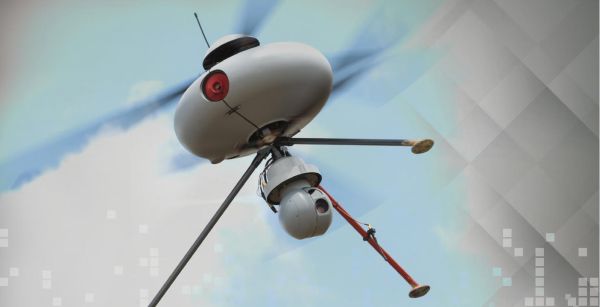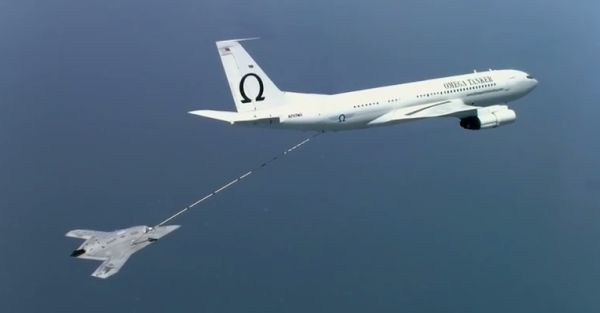Podcast: Play in new window | Download (Duration: 39:34 — 22.7MB)
Subscribe: Google Podcasts | Email | RSS
 Law firms step up to UAVs, DARPA enlists Northrop Grumman and AeroVironment for TERN, the MQ-4C Triton UAS gets new search radar, the X-47B refuels autonomously, agricultural applications for UAVs, an anti-drone drone, detecting drones by sound, and the FAA clarifies policy for drone online videos.
Law firms step up to UAVs, DARPA enlists Northrop Grumman and AeroVironment for TERN, the MQ-4C Triton UAS gets new search radar, the X-47B refuels autonomously, agricultural applications for UAVs, an anti-drone drone, detecting drones by sound, and the FAA clarifies policy for drone online videos.
News
US firms rush to set up drone departments
Michael Drobac is executive director of the Small UAV Coalition, but also the senior policy advisor at Akin Gump Strauss Hauer & Feld. He says, “’Almost every firm has a drone practice. I’m not sure every firm has a drone client.”
273 Drone Aircraft Carriers? New DARPA Contract Could Be a Game Changer
The Pentagon’s Defense Advanced Research Projects Agency (DARPA) wants the Navy to be able to launch MALE-class drones from ships at sea. Under the Tactically Exploited Reconnaissance Node, or TERN program, Northrop Grumman and AeroVironment have been selected to compete the next phase of the program and create systems where unmanned aircraft “take off and land from very confined spaces in elevated sea states and … to transition to efficient long-duration cruise missions.”
Triton UAS conducts first flight with search radar
The Navy’s MQ-4C Triton UAS has completed its inaugural flight with the new Multi-Function Active Sensor (MFAS) search radar. The radar has all-weather capability and provides a 360-degree view of a large geographic area. When operational, the Triton will dwell at high altitudes and provide 24/7 ISR coverage virtually anywhere in the world.
Fueled in flight: X-47B first to complete autonomous aerial refueling

On April 22. 2015 the first ever Autonomous Aerial Refueling (AAR) of an unmanned aircraft was accomplished with the X-47B. This completed the final test objective under the Navy’s Unmanned Combat Air System (UCAS) demonstration program. The aerial refueling was captured on video.
Researchers Seeking Agricultural Applications For Unmanned Aircraft
The University of Florida Citrus Research and Education Center recently hosted the HLB Grower Day and UAV Applications in Agriculture Workshop to look at future applications of UAVs in agriculture. The workshop was coordinated by Dr. Reza Ehsani, Associate Professor, Agricultural and Biological Engineering.
Noting that commercial operations are not yet generally allowed by the FAA, Ehsani said, “It will take at least a year until the proposed rules go through all of the approval process. So, we are probably looking to be able to use UAVs under these regulations sometime in 2017.”
Yet research continues:
- Spain’s Institute For Sustainable Agriculture is conducting research on crops using quad-rotor UAVs taking images to discriminate between crops and weeds.
- The University of Central Florida developing a UAV to inspect plants in fields in conjunction with a ground robot. A quadcopter collecting less expensive lower resolution imagery identifies potential problems and sends the ground robot in for a more detailed inspection.
- The University of Pennsylvania’s GRASP Lab is developing a concept where swarms of hummingbird-sized autonomous UAVs fly close to the ground to map the environment. In research conducted in California, a UAV flew between 26 rows of citrus trees and counted 479,395 fruits.
France’s anti-drone drone can spot malicious pilots in under a minute
In response to the number of suspicious drones flying over Paris landmarks, French firm ECA Group has a solution: an anti-drone drone. It chases down rogue drones, triangulates the location of its pilot, moves in to photograph the offender, and notifies the police. ECA won’t say how it works.
The low-tech anti-drone technology at the Boston Marathon today involves net guns and text messages
Massachusetts State Police declared Boston a no-fly zone for drones during the recent Boston Marathon. To help enforce the ban, officials utilized the DroneShield drone detection and warning system. DroneShield uses “acoustic detection technology” to listen for the telltale sound of a drone.
FAA Backs Off On UAS Videos
On April 8, 2015 the FAA sent a policy notice to Aviation Safety Inspectors on the subject of Aviation-Related Videos or Other Electronic Media on the Internet. [PDF] The notice states, “Electronic media posted on a video Web site does not automatically constitute a commercial operation or commercial purpose, or other non-hobby or non-recreational use.” Inspectors “are expected to use critical thinking when addressing electronic media” that shows potentially noncompliant activity.
The FAA will use education to encourage voluntary compliance and provided a “UAS Informational Letter Template” for Inspectors when a written notification is needed.
Volz Launches New DA26-D Redundant Servo for Demanding UAV Applications
German company Volz Servos has released its new fully redundant DA 26-D actuator for high reliability applications. The actuator, electric motors, control and communication electronics, and power supply are all redundant. Also, there are integrated sensors that provide diagnostic information like current consumption, supply voltage levels, and temperature readings.
Video of the Week
Watch This Homeowner Shoot Down a Drone Flying over His Property
In this report from Inside Edition, we see a homeowner shoot down a drone over his property. But is it real or is it a promotional stunt? Is it unauthorized commercial use and reckless discharge of a firearm? Will the authorities respond?
